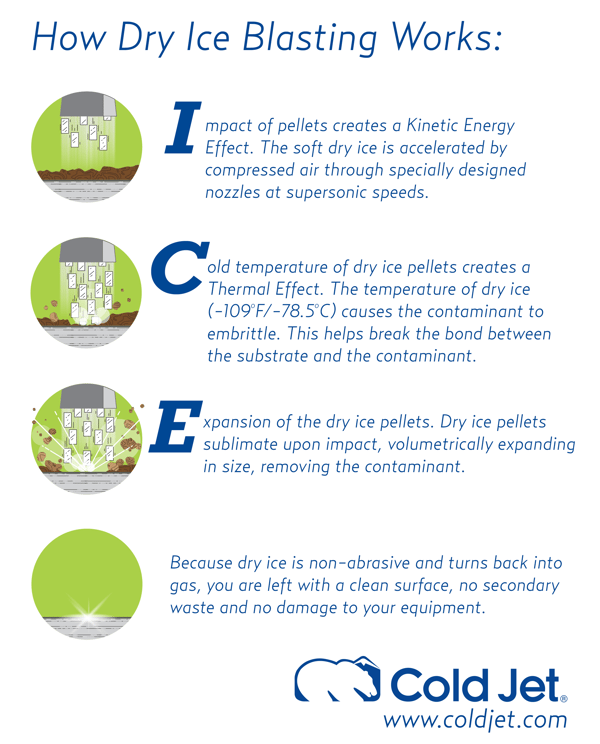
How Dry Ice Blasting Works: The Science Behind the Process
Many people ask us, "How does dry ice blasting work?" Our answer is, "There's more to it than meets the eye!"
Other media blasting methods rely primarily on the kinetic force to remove contaminants, which is generated by the media impacting the surface. Given the unique properties of dry ice, the dry ice blasting method relies on the kinetic force as well, but also incorporates two other factors that lead to a more efficient cleaning process.
Before we get into the specifics of how dry ice blasting works, let's simplify it and create a catchy acronym that makes it easier to remember the three factors. At Cold Jet, we like to use the acronym ICE:
Impact
Impact of pellets creates a Kinetic Energy Effect. The soft dry ice is accelerated by compressed air through specially designed nozzles at supersonic speeds.
Cold
Cold temperature of dry ice pellets creates a Thermal Effect. The temperature of dry ice (-109°F / -78.9°C) causes the contaminant to embrittle. This helps break the bond between the substrate and the contaminant.
Expansion
Expansion of the dry ice pellets. Dry ice pellets sublimate upon impact, volumetrically expanding in size, removing the contaminant.
Have more questions about dry ice blasting? Check out our Definitive Guide
The Three Primary Factors of Dry Ice Blasting
This is an easy way to remember how dry ice blasting works, but let's explore more in depth the three primary factors that contribute to the cleaning process. Dry ice blasting combines three primary factors to remove contaminants:
- Pellet Kinetic Energy
- Thermal Shock Effect
- Thermal-Kinetic Effect
1) Pellet Kinetic Energy
Dry ice is accelerated by compressed air through a nozzle at supersonic speeds. When the dry ice collides with the substrate being cleaned it creates a kinetic effect.
This effect has the largest contribution to the cleaning process when substrates are at ambient temperatures or below.
Even at high impact velocities and direct head-on impact angles, the kinetic effect of solid CO2 pellets is minimal when compared to other media (grit, sand, PMB). This is due to the relative softness of a solid CO2 particle (1.5 – 2 on the Mohs Scale of Hardness), which is not as dense and hard as other projectile media.
Also, the pellet changes phase from a solid to a gas almost instantaneously upon impact. Very little impact energy is transferred into the coating or substrate, so the dry ice cleaning process is considered to be non-abrasive.
2) Thermal Shock Effect
The temperature (-109°F / -78.9°C) of the dry ice causes thermodynamic shock, which causes the contaminant to embrittle and shrink. The resulting micro-cracking helps break the bond between the surface and the contaminant.
The instantaneous sublimation (phase change from solid to gas) of dry ice upon impact absorbs maximum heat from the very thin top layer of the surface contaminant. Maximum heat is absorbed due to latent heat of sublimation.
The very rapid transfer of heat into the dry ice from the coating top layer creates an extremely large temperature differential between successive micro-layers within the contaminant. This sharp thermal gradient produces localized high shear stresses between the micro-layers. The shear stresses produced are also dependent upon the contaminant’s thermal conductivity and thermal coefficient of expansion / contraction, as well as the thermal mass of the underlying substrate.
The high shear produced over a very brief period of time causes rapid micro-cracking between the layers leading to the failure of the bond between the contaminant and surface of the substrate.
3) Thermal-Kinetic Effect
Upon impact, the combined impact energy dissipation and extremely rapid heat transfer between the pellet and the surface causes the dry ice particles to sublimate or expand instantly and return to the natural gas state.
During this phase transition from solid to gas, the volume of dry ice expands up to 800 times in a few milliseconds and lifts the contaminant off of the substrate. This is effectively a “micro-explosion” at the point of contact.
The "micro-explosion," is enhanced for lifting thermally-fractured coating particles from the substrate. This is because of the dry ice particle’s lack of rebound energy, which tends to distribute its mass along the surface during the impact.
The CO2 gas expands outward along the surface and its resulting "explosion shock front" effectively provides an area of high pressure focused between the surface and the thermally fractured contaminant particles. This results in a very efficient lifting force to carry the particles away from the surface.
Want to learn more about dry ice blasting?
Download our Definitive Guide to Dry Ice Blasting
.png) English
English